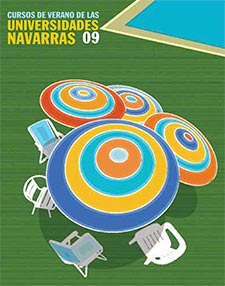BRINGING THE HERITAGE CLOSER. ESTELLA, ART AND THE ROAD
25 August 2009
Image of God, image of man: the façade of San Miguel in Estella
Javier Martínez de Aguirre Aldaz. Complutense University of Madrid
The doorway of San Miguel de Estella stands out as one of the most important sculptural ensembles of the Spanish and European late Romanesque period, due to the quality of its forms and, especially, to the richness and rigour of the figurative programme it displays. Although the absence of documentation leads us to ignore both the personalities of its promoters and the circumstances of its creation, it is nevertheless possible to guess what were the concerns that guided the clerics who developed the religious speechembodied in images by a workshop of sculptors of Bmerit around 1170.

Façade of the church of San Miguel de Estella, c. 1170
The tympanum with the image of Christ, accompanied by the symbols of the evangelists and the statues of Mary and Saint John the Evangelist, is framed by five archivolts in which, in strict order, angels with censers, the elders of the Apocalypse, the prophets and patriarchs, scenes from the life of the Lord and scenes from the lives of saints are depicted. Thus, seen from the inside out, the whole manifests the Glory of Jesus Christ-God and, from the outside in, the path that the Christian must follow to reach this Glory. The capitals display passages from the Infancy of Jesus, which insist on the fact of his Incarnation, while one of the side friezes is dedicated to his Resurrection, testof his divinity. The apostles on the sides bring before our eyes those who spread the Gospel message and the reliefs dedicated to St. Michael summarydepict passages featuring the patron saint of the church.

Doorway of the church of San Miguel de Estella. Detail of the tympanum
It is thus clear that the sculptural programme focuses on one of the main dogmas of Christianity: Jesus was true God and true man, and in following him lies the salvation of the faithful. This idea of the dual nature is reinforced by the registrationthat runs along the mandorla, through which the spectator-reader (an educated spectator, with knowledge beyond the averageof his time) felt challenged: "The image you contemplate is neither God nor man, but he is God and man whom the sacred image represents". This text had been used by the theologians of the time to express the right doctrine on the lawfulness of images of God, so it is possible that it was included on the Estellan title page in order to stop some kind of iconoclasm or rejection of images, perhaps related to the spread of the heresies that were developing in the South of France at that time. We must not forget that many of the inhabitants of the town and a good percentage of the pilgrims who passed through it on their way to Santiago de Compostela came from that region.
PROGRAM
TUESDAY, AUGUST 25
The splendor of Estella in the Renaissance. Art and Artists
Ms. María Concepción García Gainza. Chair of Navarrese Heritage and Art.
Image of God, image of man: the façade of San Miguel de Estella
Mr. Javier Martínez de Aguirre Aldaz. Complutense University of Madrid
San Pedro de la Rúa: styles and interstyles in a medieval building.
D. Carlos J. Martínez Álava. I.E.S. "Pedro de Ursua" of Pamplona
WEDNESDAY, AUGUST 26TH
Following in the footsteps of the Gothic in Estella: Santo Sepulcro and Santo Domingo
Ms. Santiaga Hidalgo Sánchez. Chair of Navarrese Heritage and Art.
Estella's movable heritage
Ms. Mercedes Jover Hernando. Chair of Navarrese Heritage and Art.
A city born for the Camino. visit guided tour of the city of Estella
D. Román Felones Morrás. Full Professor of Geography and History of the I.E.S. Tierra Estella.
THURSDAY, AUGUST 27TH
Architecture and Humanism in Estella in the 16th century.
Mrs. María Josefa Tarifa Castilla. Chair of Navarrese Heritage and Art.
Traces of the Baroque in Estella
Ms. Pilar Andueza Unanua. Chair of Navarrese Art and Heritage.
The sumptuary arts in Estella: from the Age average to the 19th century.
D. Ignacio Miguéliz Valcarlos. Chair of Navarrese Heritage and Art.
FRIDAY, AUGUST 28TH
Images of a conflict. Estella and the last Carlist War
D. Ignacio Jesús Urricelqui Pacho. Chair of Navarrese Heritage and Art.
reportIdentity and image of Estella in the plastic arts of the 19th and 20th centuries.
Mr. José Javier Azanza López. Chair of Navarrese Heritage and Art.
Museum and city. Gustavo de Maeztu and Estella
D. Gregorio Díaz Ereño. Director of the Jorge Oteiza Museum.
Closing

